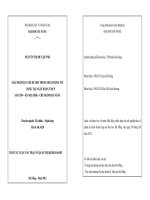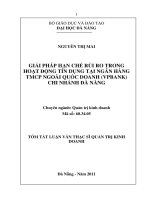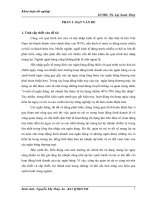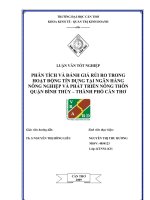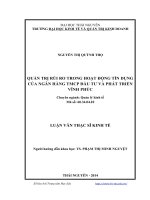Quản lý rủi ro trong hoạt động tín dụng tại ngân hàng TMCP techcombank
Bạn đang xem bản rút gọn của tài liệu. Xem và tải ngay bản đầy đủ của tài liệu tại đây (408.6 KB, 71 trang )
LUẬN VĂN
Quản lý rủi ro trong hoạt động tín dụng tại ngân hàng TMCP Techcombank
THESIS
CREDIT RISK MANAGEMENT AT VIETNAM TECHNOLOGICAL AND
COMMERCIAL JOINT- STOCK BANK - TECHCOMBANK
1
Chapter I - The opening.
1. Why choose theme?
Vietnam's economy for more than a decades there have been steps boom not only
in the region but also spread out all over the world. According to the General
Statistics Office Vietnam total domestic income (GDP) of Vietnam in 2007
reached approximately 1114 trillion equivalent to 71.4 billion dollars) increased
by 8% over 2006. To get the achievement that the role of banks is important. The
role of banks has helped stabilize the economy is more in the past year.
Commercial Joint Stock Bank Technical Trade of Vietnam - Techcombank is a
bank in Vietnam has made tremendous positive contributions. Growth of bank
credit over the years has increased. However, besides the increase in the status of
overdue debts at the bank contains many potential risks.
Group has chosen 11 research projects: credit risk management in Techcombank
"as key themes for your comment. This topic hoph consistent with the situation
assessment practices contribute to prevent credit risks in banks in Vietnam and at
the same time improving the efficiency of credit management at the bank prices.
2. Objectives of research:
+ Study the basic theories of active credit risk management and business strategies
of commercial banks Vietnam
+ Role of the importance of credit to enterprises in economic development
+ Measures to limit credit risk
+ The proposed uniform and high-performance computer controls contribute to
credit risk in commercial banks in Vietnam.
3. Scope of research:
Subjects studied: Customers in Techcombank
Scope of research: Research on the state of credit risk management and business
2
strategy in Techcombank and effective solutions.
Time research: From 2006 to 2008.
4. Research Methodology:
Collection, statistical data, interpret and draw conclusions. Analysis of data on the
relative and absolute. From which to draw comments on credit risk management
and business strategies in prices.
5. Structure of course comment;
Chapter 1: The opening
Chapter 2: General Theory of planning business strategies of enterprises.
Chapter 3: Status of credit risk management and business strategies in prices.
Chapter 4: The solutions for credit risk management and business strategies in
prices.
CHAPTER II - GENERAL THEORY STRATEGIC PLANNING BUSINESS
ENTERPRISES
I. OVERVIEW OF BUSINESS STRATEGY.
1.1.1. What is business strategy
The term “strategy” originated in the art of war in olden times. It is considered as
the art of commanding means to win. Borrowed from military term, the word
“strategy” is used popularly in both macro and micro economy. There are many
conceptions about strategy such as:
- Strategy is an art of creating competitive advantages to defend (M.Porter).
- Strategy is to define the way and means to reach the specific target through
policies (General Aileret).
- Strategy is an art of combining and controlling actions to achieve long term
targets (G.Hirsch).
3
According to another approach, “Strategy” is a manner that helps company answer
questions: “Were do we want to go? Where and how we can go? What do we
have? What do others have?”
From the above conceptions, the term strategy of a company implies and reflects a
target in a long-term (3, 5 or 10 years). The process of deciding a strategy included
competitive environment, strengths and weaknesses. We can see that a company
strategy is a product. It combines the environment factor and the things that the
company can reach and want to reach.
Through times, the conceptions of strategy have changed. There are now two
popular conceptions:
- Business strategy is a mean to achieve the long-term target. The idea of business
strategy is to attack and to win in competitive market.
- Business strategy is a set of long-term target, policies, production and business
solutions, finance and human factor to develop the company business activities
and reach higher quality.
In summary, business strategy is an art of optimal organizing and combining
resources. It proposes and implements the decision that is suitable to the variable
trend of environment to win in competitions and reach the long-term target.
1.1.2. Specific meaning of Business strategy
We can see the basic figures of business strategy are:
- Business strategy has to specify the basic target in each phase and be grasped
thoroughly.
- Ensure to mobilize totally and combine optimally the using of human and
financial resources. Take full advantage of opportunity to contend with other
competitors.
- Is reflected during a continuous process from building to evaluating, inspecting
and adjusting strategy.
4
- Is built and implemented in a long-term period (3, 5 or 10 years).
In the market mechanism, the building and deploying business strategy has an
important meaning to the existence and development of a company.
- It helps the company recognize the target and direction. It is the foundation for
determining the orientation and when the company can reach the specific target.
- The market fluctuation always creates opportunity and risk. To build and
implement business strategy will help the company grasp and take advantage of it
and overcome the market risk and trap.
- To build and implement business strategy will firmly create foundation for
suitable decision.
- To build and implement business strategy will take part in increasing the
effectiveness of using resources. Reinforce the competitive position and ensure an
unshakeable development.
1.1.3. The necessary of Company Business strategy
1.1.3.1. Financial benefit
The researches show that if a company has a good strategy, it will be successful.
The company that has good financial condition trends to plan for the internal and
external fluctuation.
1.1.3.2. Non financial benefit
With the strategy, the company operation will follow one direction. This will bring
success and high benefit. It helps the company to develop with a stable
organization and relationship… It will raise the productivity and reduce the risk.
Besides, it will bring order and discipline to the company. It is the beginning of an
effective administration system, restore the belief of current business strategy and
execute the correcting activities.
1.2. Building and choosing the Company Business strategy
5
1.2.1. Process of Business strategy.
The conception of administration appeared for a long time but the administrative
theory that was researched basing on the scientific analysis appeared in late 19th
and early 20th decade.
Strategic administration is a process of researching environment to set up strategic
targets, policies and solutions. It will help organization to bring out strategies,
policies and give decision of correcting, inspecting, evaluating the business
strategy execution.
1.2.1.1. Phase of Forming strategy
Forming strategy is a process of setting up the business task, surveying the internal
and external factors, proposing the long-term targets and choosing replaceable
strategies. It has 3 basic activities:
-
Research: collect and handle information about market. This is called “Take a
glance at the business environment”. Basically, it specifies strong and weak points
in the business field. Other surveys could be executed such as employee spirit,
productivity, advertisement and customer loyalty.
-
Combine intuition and analysis: A few companies can develop prosperously
with intuitional genius managers. But most of the company gets benefit from
strategy by combining harmoniously intuition and analysis in giving decision.
Give decision: no organization has infinite resource. Therefore strategists must
give decision about choosing an effectively replaceable strategy. The decisions in
this phase are about product, market, resource and technology.
1.2.1.2. Phase of performing strategy
This is a phase of action. That means to mobilize all administer and employee to
execute the planned strategies. The basic activities are:
- Set up annual targets: they are the milestone that companies have to obtain to
reach the long-term target.
6
- Policies: they are means to achieve the target. They include the instructions,
regulations and procedures to support for reaching the targets.
- Distribute resources: it is an administrative activity that pays attention to the
strategic execution. Strategic administration allows companies to distribute the
resources. They are established by annual targets. There are 4 resources can be
used:
+ Financial resource
+ Material resource
+ Human resource
+ Technical resource
In summary, this phase is the most difficult one. The execution requires discipline,
devotion and sacrifice of each staff. It will be successful if the managers can
impulse staffs. It is an art rather than a science.
1.2.1.3. Phase of evaluating strategy
It is very necessary to have this phase in each company. A timely evaluation will
alarm the problems so that administers can interfere before they become more
serious.
Timely feedback information is the foundation of strategic evaluation. Richard
Rurnel has proposed 4 standards of evaluating strategy:
+ Consistency
+ Suitableness
+ Advantage
+ Feasibility
7
8
Figure 1.1: Strategic business of administration model –
Feedback information
Specify the responsibility of target and current
strategy
Control
external factors
to specify
opportunity
and risk.
Set up shortterm target
Inspect
and
evaluate
Reconsider the
business target.
Control
external factors
to specify
opportunity
and risk.
Set up shortterm target
Distribute
production
resource
Choose
strategies
Propose
policies
9
1.2.2. Analysis of Company Business environment
1.2.2.1. Factors of Business environment
A good strategic management depends on the knowledge of companies about the
environment that they are coping with. The environment factors have wide and
deep affect to the next step of the strategic management process.
The 3 levels of environment that companies have to face are: macro environment,
operation environment and internal environment.
Figure 1.2 Business environment factors
Competitors
Economy
Providers
Technology
Company
Institution
&
law
Customers
Replaceable products
Society
Nature and
environment
The macro environment includes external factors. It affects to the operation
environment and internal environment. It creates opportunities as well as risk for
companies.
The operation environment includes external factors. It orients the competition in
the business.
10
The internal environment includes the company resources.
Macro environment
The analysis of macro environment will help the company answer the question:
“What is it now coping with?”
We have 5 factors mentioned in table 1.1: economy, government and politic,
society, nature and technology.
11
Economic
Government and
factors
political factors
Period of
Regulations of
economic cycle
consumption
Natural
Technical
factors
factors
Opinion about
Environment
Cost of
living standard
pollution
researching and
Social factors
lending
Financial
Antimonopoly
resource
policies
developing
Living style
Lack of energy
Cost of internal
research and
development
Trend of GNP
Environment
Female labor
protection laws
Waste of
Technical efforts
natural
resource
Inflation rate
Interest rate
Tax laws
Career
Copyright
aspiration
protection
Regulations in
Active
Technology
line of foreign
consumption
transfer
trade
Currency policy
Special treatment
Birth rate
New products
Jobless rate
Regulations of
Increasing
Using human,
lending and
population rate
machine
Stability of
Shifting of
Automation
government
population
promotion
Financial policy
Price control,
wage
Balance of
payments
Table 1.1. The macro environment factors
12
Economical factors
The economical factors take much affect to the company. They are interest rate,
period of business cycle, balance of payments, financial and currency policy. The
company has to select the specific impact. Each factor may be opportunity or risk.
Government and Political factors
The government and political factor impact to the company activities. The
company has to conform to the regulations of tax, loaning, insurance,
advertisement, environment protection… The government activities can create
opportunity as well as risk.
Social factors
The company needs to analysis social factors to recognize opportunities and risk.
If these factors can affect to the company such as: anthropology trend, interest of
entertainment, standard ethics, female labor…
Natural factors
The impact of the natural factors to company has been admitted. However the
company has not paid much attention in maintaining the natural environment.
Technical factors
Most of the industrial business and companies depend on the technology. There
will be more advanced technologies coming out into society. They will create
opportunities and risks to every industrial business and companies.
1.2.2.2. Operation environment
Because the (common) influences of these factors are unavailable for all
companies, the key to setup a successful strategy is analyzing each of these main
factors.
13
The understanding of competition pressure sources helps company to recognize its
weaknesses and strengths relating to opportunities and risks that company will
encounter.
Figure 1.3: The relation between factors in the
operation environment of a company
Competitor
New competitor risk
Price squeeze
ability of
suppliers
Potential Competitor
Price squeeze
ability of
buyers
Suppliers
Customers
Competition between
companies in the same
line of business
Replacement risk
Replacement
14
Competitors
The understanding of competitors has an important meaning for companies
because of many reasons.
Figure 1.4: Main parts of competitor analysis is
presented as follow
What they want to
reach?
Future
purpose
Multidimension
al management
What they can do and
will be able to do?
Some questions have to
answer about the
competitors
- Do they satisfy with their present
position?
- What are their ability?
- What are their weaknesses?
- What can help them react in the
most powerful and effective way?
Analytical review
How can it effect
on company and
industry?
Present
strategy
How is the
competitive
ability of the
company?
Potential
Strengths and
weakness
Firstly, competitors determine competition property, competition level and
advantage struggle skills. Level of competition depends on interrelation among
factors, such as number of competing companies, growth rate of sector, fix cost
structure and level of product diversity. Existence of these factors has tendency to
15
increase demand or expectation of company for achieving and protecting their
market share. So, that makes competition more severe. Companies should admit
that competition process is not stable.
Beside new competitors, new technology solutions affect property and level of
competition.
Companies should analyze each competitor to master actions and reactions they
may approve.
Customer
Customer problem is not apart from competition environment. Goodwill is the
most valuable property. The goodwill achievement is due to company meets the
demand better than competitors do. Other key problem is bargaining ability of
customer.
The buyer has ability of decreasing the benefit of a business sector by mean of
price squeezing or requiring higher quality and more services.
Supplier
Companies have relations with supplying organizations who supply many kinds of
goods such as materials, devices, labor, capital.
- Device supplier
Device supplying organizations has advantages and be able to get much profit by
mean of decreasing product quality or accompany services.
Factors increasing strength of supplying organization are similar to factors
increasing strength of buyer.
- Number of supplier is little
- There isn’t replacement
- There isn’t supplier offering different product
16
Supplier selection relies on seller analysis result. Analysis supplying organization
has importance significance for any company. In some certain time, most
companies including well-doing ones, have to temporarily borrow money from
financial market. They can use this capital source by short-term borrowing, longterm borrowing capital issue. Before analyzing capital market, company should
pay attention to define its position in competition with others.
Labor source is a main factor in company’s competition environment. The ability
of attractiveness and hold competence employees is prerequisite to ensuring
success of company. Main factors need analyzing:
Potential competitor
New-started competitor is a factor decreasing benefit of company because it sets
into extraction new production ability with desire to secure market share and
necessary resources.
Buyback other companies in the same business in order to building market share is
normally a manifestation of appearing new competitors. Although company does
not always have new potential competitors at any time, the danger of new
competitors integrating in business has influence on company’s strategy.
A barrier preventing the entering is strong withstanding of well-established
company.
Replacement
The pressure of replacement restricts potential benefit of a business because higher
price is limited. If a company not pay attention to replacement, it may fall behind
with small market share.
Hence, company should incessantly research and check new potential
replacement. Most of replacement is result of technology explosion. To get
achievement, company need pay attention to using resources to develop and apply
new technology in its strategy.
17
1.2.2.3. Internal environment
Internal environment includes all factors and systems inside company. It’s
necessary to throughout analyze these factors because it overcomes weaknesses
and promote strengths. Internal environment factors include:
- Human resource
- Production research and development
- Finance and accounting
- Marketing
- Organization discipline
Human resource factors
Human resource takes a very important role in the success of company. Human
provide input data to form target and analyze environment. Although opinions of
general planning system is absolutely correct, it can not bring benefit if lack of
competent man.
Research and development factors
The quality of research and development is a factor which determines company in
the top or behind position in comparison with other leading company in area of
product development, product quality, price control and production technology.
Qualification, experience and scientific ability are not enough foundation for good
research. Research and development department have to closely monitored
environment factors and technology innovation regarding technical process,
product and materials.
The effective information exchange between research and development
department and other departments take an important role in the success of
company.
Production factors
18
Production is a line of business connecting to produce process. This is the main
business line, so it influences on success ability of company.
There are many positive influences of high quality product with low cost.
Marketing team has advantage of easy selling.
Finance division has advantage of effective production facilities economizing
capital resource. Production section also has big impact on human resource
department.
On the other hand, weak production results on unmarketable product, financial
loss and indifferent attitude of employees.
Financial and accounting factors
Function of finance sector includes analyze, plan and check implementation of
financial plan and financial position of company. Small company can use one
person responsible for finance problem and hold concurrently: accountant,
financial record keeper, manager or financier.
Large company can organize many departments as: financial accounting, inspector
department.
Financial sector has responsibilities relating to resources such as:
- Resource finding including capital resource finding
- Expenditure control
Marketing factors:
Function of marketing includes analyze, plan, execute and check the program, in
there it focus on training and maintain the relationship with customers on principle
of mutual benefit. Therefore, marketing tasks is monitoring level, time and
property of demand; that helps organization achieves goals and form effective
strategy of product, assessment, communication and distribution suitable for target
market.
19
Organization discipline:
Each company has its own discipline to orient most of work. It influences on
decision modality and opinion of managers wits regard to strategy and operation
environment.
The discipline is a weakness impeding strategy forming and implementing or a
strength promoting these activities. Company with strong and positive discipline
has more chances to succeed than the other one with weak and passive discipline.
Company is like a live-body because man makes it operate and form its sense and
goals. Organization discipline is a collection of experience and internal climate
which unite together to form “The way we do our work”
Organization discipline is an interaction mechanism with environment.
1.2.2.2. Analyzing business environment
Information collecting:
Purpose of information collecting is monitoring business environment to define
trend, level, speed and amplitude of change of environmental effects.
Environment factor identifying defines impact of environmental changes on
company and almost strategy of company.
Normally, steering committee makes light of information collecting after it has
been carried out. Company can collect information in only one day, one weed or
longer depending on certain kind of information need collecting.
Nowadays, there is information overload. So it is important for information
collecting to grasp necessary information and wits right form.
Conclusive table:
This table is useful mean for analyzing macro-environment, competition
environment and internal situation.
20
The table synthetizes factors and estimates impact of the factor on company.
1
2
Environment
The
factors
level of factors
Basic
Classify
environment
important level of of
listing
3
important
4
5
Propety of Grade of
Impact on company
impact
factors
relative Classify impact level
and each factor :
factor
on Describe
company:
their
3=
components
medium, 1= low
high,
each
nature
of
2= 3= much, 2= medium, impact
0= no impact
Column1: List most important environmental factors and their components
Column 2: Classify environmental factors according to their important level
Column 3: Classify impact of each factor
Column 4: Describe impact of each factor
In the table, we see which factor impact and how it influences on company. The
positive factors have positive sign. The passive factors have negative sign. To
evaluate nature of factors, we have to compare bottom line.
Propose reaction strategy:
Up to now, steering committee have enough condition to make decision and
method to respond to opportunities or danger arising. There are many methods of
strategy reaction but company would do nothing if opportunity or danger is not
remarkable.
Strategy is made on forecast basic of business environment. In fact company could
encounter unexpected situation. To take precautions of inaccurate forecast,
company should have flexible and concrete strategy.
1.2.3. Some evaluation model
1.2.3.1. Peripheral factor evaluating matrix
21
Building process of EFE matrix includes 5 steps:
Figure 1.5: Building process of EFE matrix
List
all the
peripheral
factors
Define
important
level of
each factor
Give
coefficient
for each
factor
Grade
each
factor
Add mark
for each
factor in
the list
Step 1: List factors has decisive role in the success of company (10-20 factors)
Step 2: Define important level from 0,0 (not important) to 1,0 (very important).
Total of level on the list is 1.
Step 3: Define coefficient from 1 to 4 of each factor in relation to responsive
ability of company
4: Best response
3: Upper medium
2: Medium
1: Lower medium
Step 4: Grade each peripheral factor by multiplying coefficient and important level
Step 5: Add the grades of all factor list. If result is 2.5, it is medium, 4 is the
highest and 1 is the lowest.
In short, micro and macro factors can combine together in many ways, direct or
indirect impact on company to create opportunities or threats.
The importance is to analyze, evaluate level of impact and responsive ability of
current strategy in the fight against the changes.
22
1.2.3.2. BCG Matrix
Figure 1.6: BCG matrix
Question mark
Star
Dog
Cow
Main purpose of BCG is helping strategy manager to recognize the requirement of
different SBU (Share of Business Unit) in investment list.
BCG includes 3 steps:
- Company is divided into some SBU, each SBU is evaluated of its prospect.
Compare SBU in a square matrix, show their prospect
Star: SBU in top position
Question mark: SBU in weak position
Cow: SBU in low growth rate business but has high market share
Dog: SBU in low growth rate business and has small market share
1.2.3.3. HOPER Matrix
Corporate-level strategy determining relies on two factors:
The competitive position and the stages of business cycle.
23
Combination of these 2 factors determines the best strategy for each stages of
business.
Figure 1.7: Hoper matrix
Embryo
Market share building Market share building
Rising
Developing
Fluctuation
Market share raising
Growing
Slackening
Market concentrate
Market concentrate or
dissolve
Strengthen and gain
Reap or dissolve
profit
Market concentrate or Situation reverse or
asset reduce
dissolve
1.2.3.4. SWOT Matrix
S: Strengths
O: Opportunities
T: Threats
W: Weaknesses
SWOT analysis, method, or model is a way to analyze competitive position of
your company. SWOT analysis uses so-called SWOT matrix to assess both
internal and external aspects of doing your business. The SWOT framework is a
tool for auditing an organization and its environment.
SWOT is the first stage of planning and helps decision makers to focus on key
issues. SWOT method is a key tool for company top officials to formulate
strategic plans. Each letter in the word SWOT represents one strong word:
S = strengths, W = weaknesses, O = opportunities, T = threats.
24
To build SWOT Matrix, the first step is listing strengths, weaknesses,
opportunities and threats, then comparing in a systematic way each correlative
level among factors to make combinative level.
- S/O: combination is gain from combining main strengths and Opportunities.
Company uses strengths and opportunities to compete with others and non-stop
expanded market.
- W/O: combination is the association of weaknesses and opportunities. This
combination opens up an ability of overcome weaknesses by means of
opportunities
- S/T: Combination is the association of strengths and threats, it pays attention to
use strengths to overcome threats.
- W/T: combination is the association of weaknesses and threats. It demands
company decrease weaknesses by means of setting up defensive strategy.
CHAPTER III - THE ISSUE CREDIT RISK MANAGEMENT AND
BUSINESS STRATEGY IN TECHCOMBANK
I - Introduction to Techcombank
1.1 History of Techcombank
Vietnam Technological and Commercial Joint- stock Bank - Techcombank was
established on September 27th, 1993 with the initial registered capital of VND 20
billion with the aim to become an efficient financial intermediary bridging the
25


